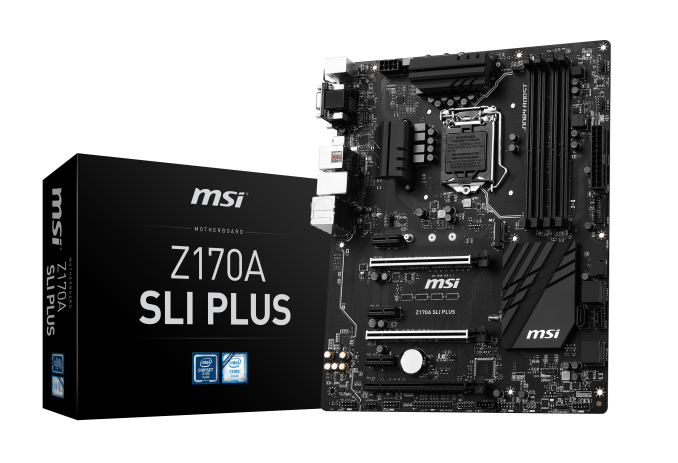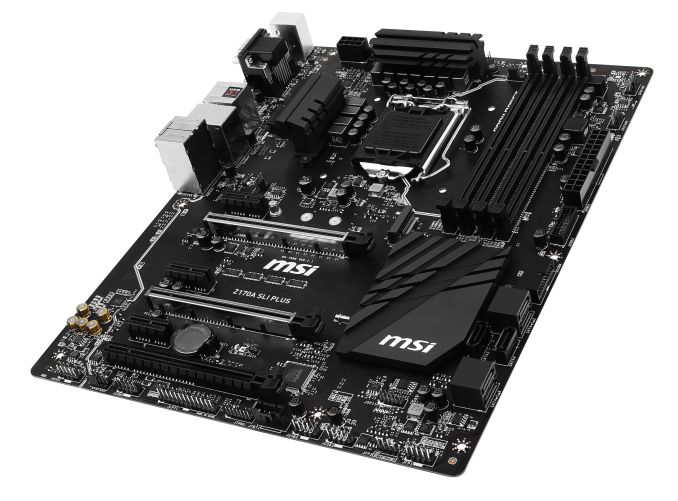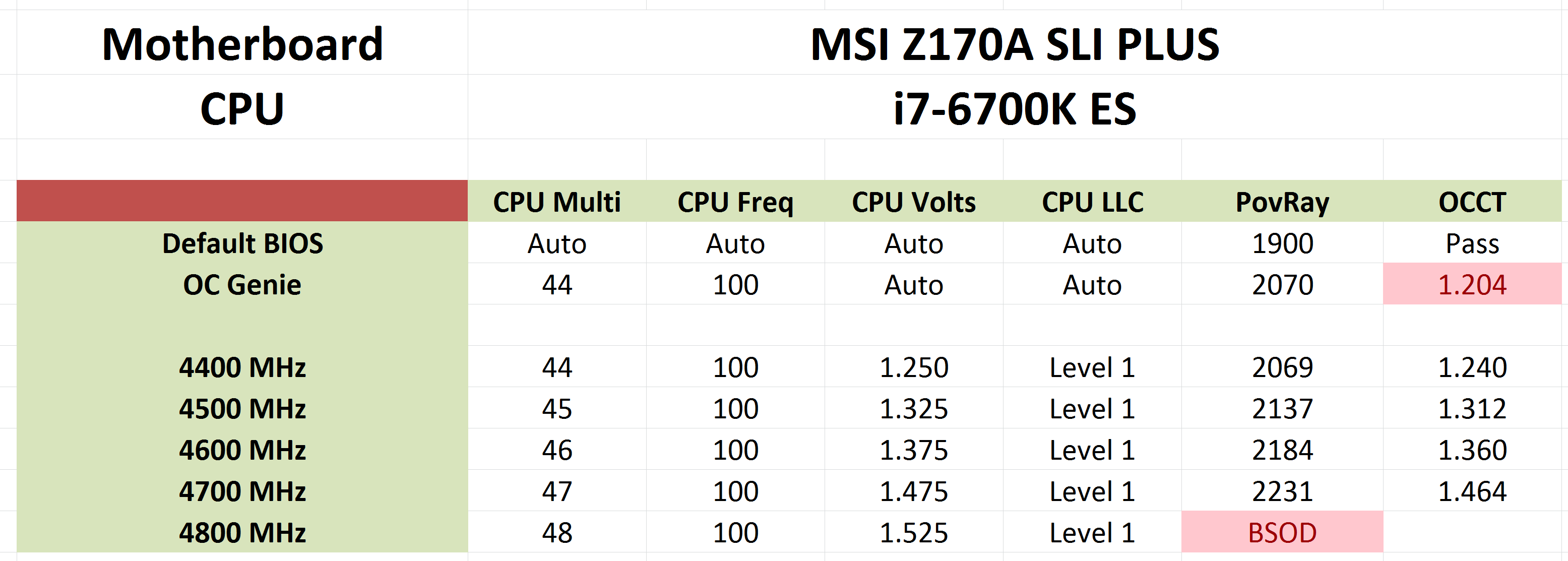The MSI Z170A SLI PLUS Review: Redefining the Base Line at $130
by Ian Cutress on April 13, 2016 8:00 AM EST- Posted in
- Motherboards
- MSI
- Skylake
- Z170

MSI’s motherboard range seems to expand every generation. Alongside the channel range, there’s the MSI Gaming, micro-ATX gaming, OC Certified, Krait, ECO, SLI PLUS, PC Mate and some I probably can’t think of. Each set can have a chipset mix, depending on their target market. The SLI PLUS line is relatively new, with the Z170A SLI PLUS in this review being the latest model. The goal of the SLI PLUS is form, function and application at a low price, with a few future-proof features and enough hardware for most PC enthusiasts systems. They seem to sell well, so we got a sample in to see the fuss. Two word verdict: pleasantly surprised. Read on to see why.
Other AnandTech Reviews for Intel’s 6th Generation CPUs and 100-Series Motherboards
Skylake-K Review: Core i7-6700K and Core i5-6600K - CPU Review
Comparison between the i7-6700K and i7-2600K in Bench - CPU Comparison
Overclocking Performance Mini-Test to 4.8 GHz - Overclocking
Skylake Architecture Analysis - Microarchitecture
Z170 Chipset Analysis and 55+ Motherboards - Motherboard Overview
Discrete Graphics: An Update for Z170 Motherboards - PCIe Firmware Update
Price Check: Intel Skylake i7-6700K and i5-6600K - Latest Skylake Price Check (3/29)
100-Series Motherboard Reviews:
Prices Correct at time of each review
($500) The GIGABYTE Z170X-Gaming G1 Review
($500) The ASUS Maximus VIII Extreme Review
($250) The ASUS Maximus VIII Impact Review
($240) The ASRock Z170 Extreme7+ Review
($230) The MSI Z170 Gaming M7 Review
($208) The GIGABYTE Z170-UD5 TH Review
($165) The ASUS Z170-A Review
($130) The MSI Z170A SLI PLUS Review (this review)
($125) The Supermicro C7H170-M Review
To read specifically about the Z170 chip/platform and the specifications therein, our deep dive into what it is can be found at this link.
MSI Z170A SLI PLUS Overview
At $130 only a few overclocking class motherboards sit in this area. It marks the cross over for ATX motherboards between the high cost H series chipset motherboards (ones with special features or extra controllers such as dual network plus WiFi) and base cost Z series models, just because a motherboard that can support SLI and overclock needs to be engineered to cope with at least a 10-20% increase in frequency and 75W to each GPU. This means more efficient power delivery, more reliability, tweaking and tuning to ensure stability, a BIOS and software package with more options and the ability to use as many of the PCIe lanes from the chipset as possible. Nonetheless, the Z series motherboards nearer $100 tend to be a cost-down implementation.
The SLI PLUS comes into this market in a serious way. It comes in as one of the cheapest ways to implement SLI in the Skylake platform via the x8/x8 PCIe separation, but in many ways it also marks several years of movement from MSI to build a brand and improve the aesthetic. The MSI Z170A SLI PLUS does not look like a $130 motherboard on a first look, due to the coating used to cover up obvious trace lines but also the color consistency between black and dark grey used on the heatsinks, slots and ports. It marks in impressive change at just how regulated an aesthetic can get despite the low price, a feature normally reserved for more expensive motherboards.
For features, aside from support for 2-way SLI and PCIe guard plates to protect from large graphics cards, the motherboard gives both a USB 3.1 Type-C port on the back (provided by ASMedia’s ASM1142 controller) and a fully capable PCIe 3.0 x4 M.2 slot up to 2280 without compromising the utility of other features. The latter comes via four of the 20 PCI lanes on the chipset, one of the benefits of the 100-series chipset over previous generations. Normally in 2016 just saying a motherboard has M.2 x4 and 3.1-C is par for the course and we expect to see that on almost all of the ones that we review, but it might not be expected on a $130 product. The motherboard also uses the standard high-end audio codec (Realtek ALC1150) and network controller (Intel I219-V) that we see on $350+ motherboards, both of which are usually easy cost-down areas in cheaper products. The audio codec is improved in some of the same ways as the more expensive motherboards (PCB separation, filter caps) and it still performs very well.
For our performance metrics, the SLI PLUS doesn’t implement MultiCore Turbo by default so it falls into the second half of the table for CPU performance, but an overclock is just a click away in either the BIOS or software. But the power consumption is one of the lowest we’ve seen due to the de-complication of the design, and the POST times are in the better half of the table for the same reason. DPC Latency has been fairly dichotomous on Z170, both good and bad, but the SLI PLUS is on the good side of the split.
The BIOS and Software combination from MSI works very well. MSI is using their latest BIOS design from the high-cost motherboards at this price point, having developed a new ‘easy mode’ entry screen for Skylake last year. The software package has some minor flaws (such as voltage selection) but on the whole is easy to use and MSI’s Live Update package still shines through as a top solution from any motherboard manufacturer.
Every time we get a new motherboard in for review, my first task is to take it out of the box and have a very good look around to determine the features, controllers and layout before I look at specification sheets. The goal here is to determine how much is immediately obvious, but also to see which market it is aimed for and the feeling of what price might be paid. The MSI Z170A SLI PLUS has a solid base feature set, with a few extras over the specifications, and the presentation/layout gave the impression of a very streamlined design. When I checked the MSRP, I was surprised (my initial estimate was too high...!) and MSI has found a really nice price point for a board breezed through our testing.
Quick Links to Other Pages
Board Features, In The Box
Visual Inspection and Test Setup
BIOS
Software
System Performance (Audio, USB, Power, POST Times on Windows 7, Latency)
CPU Performance, Short Form (Office Tests and Transcoding)
Gaming Performance 2015 (R7 240, GTX 770, GTX 980)
Conclusions
Quick Board Feature Comparison
| Motherboard Comparison | ||
| MSI Z170A SLI PLUS | ||
| Socket | LGA1151 | LGA1151 |
| MSRP at Review | $130 | $230 |
| DRAM | 4 x DDR4 | 4 x DDR4 |
| PCIe Layout | x8/x8 | x8/x8 |
| BIOS Version Tested | 1.4 | 142 |
| MCT Enabled Automatically? | No | Yes |
| USB 3.1 (10 Gbps) | ASMedia ASM1142 1 x Type-C |
ASMedia ASM1142 1 x Type-A 1 x Type-C |
| M.2 Slots | 1 x PCIe 3.0 x4 | 2 x PCIe 3.0 x4 |
| U.2 Ports | No | No |
| Network Controller | 1 x Intel 219-V | 1 x Killer E2400 |
| Audio Controller | Realtek ALC1150 | Realtek ALC1150 |
| HDMI 2.0 | No | No |
MSI Z170A SLI PLUS Overclocking
Experience with MSI Z170A SLI PLUS
Automatic overclocking options from MSI have changed a little bit of the past couple of years, with the OC Genie name moving from a small single automatic overclock selection several generations ago moving to a progressive overclock dial for the high end models this generation. The Z170A SLI PLUS goes back to that single overclock selection, despite the fact that the progressive overclock could have been implemented software only. The single point overclock this time is a bit more aggressive than previous generations, but not overly so: whereas before we would get 3-5% frequency jumps, here there is a 10% jump with the i7-6700K moving from 4.0 GHz to 4.4 GHz on all cores. However, MSI is conservative on voltage and this overclock failed our stress testing.
For manual overclocking, given the price segment and hardware on board, we weren’t expecting the best OC performance and the end result was still a good mark in the sand.
Methodology
Our standard overclocking methodology is as follows. We select the automatic overclock options and test for stability with PovRay and OCCT to simulate high-end workloads. These stability tests aim to catch any immediate causes for memory or CPU errors.
For manual overclocks, based on the information gathered from previous testing, we start off at a nominal voltage and CPU multiplier, and the multiplier is increased until the stability tests are failed. The CPU voltage is increased gradually until the stability tests are passed, and the process repeated until the motherboard reduces the multiplier automatically (due to safety protocol) or the CPU temperature reaches a stupidly high level (100ºC+). Our test bed is not in a case, which should push overclocks higher with fresher (cooler) air.












62 Comments
View All Comments
HollyDOL - Wednesday, April 13, 2016 - link
Price given this board is very impressive piece of hardware...ImSpartacus - Wednesday, April 13, 2016 - link
Yeah, I'm tickled to see gems like this.That was a fun review to read.
jasonelmore - Wednesday, April 13, 2016 - link
Throw in a $20 5 Port USB 3.0 Card and this thing has everything you need.http://smile.amazon.com/dp/B00FCQPVI8
mczak - Wednesday, April 13, 2016 - link
It's missing DisplayPort. Sadly, nearly all cheaper boards miss this. So, if you don't have a need for powerful graphics and are just fine with the IGP, but you still want to hook up one of those quite cheapie 4k monitor, you're out of luck. Really wish they'd ditch those near useless VGA and DVI-D ports in favor of DP (ok the latter isn't useless but all of intel's DVI-D ports are going to be single-link, hence limited to 1920x1200) - or better instead of ditching DVI-D and VGA they should just have one DVI-I port instead for people who really want to hook up that analog monitor there...Manch - Thursday, April 14, 2016 - link
Your use case is very much a niche. 4K monitors are not the norm. Many people still have vga monitors as well. If you're going to drive a 4k display odds are you wont be using igp. I don't really see an issue here.Visual - Thursday, April 14, 2016 - link
To add to that, even if I wanted a 4k monitor, I'd personally not want to use DP for that. A port meant just for computers was a terrible idea from the start and I will never buy anything with it. I'll stick with HDMI and its future versions.And DP has the same limitations as HDMI in regards to 4k@60p - you need newer versions of either to support that.
mczak - Thursday, April 14, 2016 - link
No, you only need DP 1.2 for 4k@60p (with no chroma subsampling). Everybody supports that since like forever. But for the same with HDMI, you need HDMI 2.0, which isn't supported by anything intel ships. All 4k monitors (but, of course, not TVs) support DP 1.2 too (except some very old models). I don't disagree HDMI 2.0 wouldn't be nice, but with Skylake IGP it's just not going to happen.mczak - Thursday, April 14, 2016 - link
To clarify, intel supports DP 1.2 since Haswell.And FWIW there's still quite a lot of 4k monitors you can buy today which actually do not support HDMI 2.0 neither - they _require_ DP for 4k@60p.
(There actually is a way for skylake based systems to do HDMI 2.0 - the Alpine Ridge TB controller can do that. Clearly, not an option for budged oriented boards. Kaby Lake however should support HDMI 2.0.)
mczak - Thursday, April 14, 2016 - link
Well, if you just want a gorgeous looking monitor for web browsing, office work or whatever, the IGP would do just fine with a 4k monitor (fwiw apple ships plenty of exactly such configurations).But sure 4k gaming isn't going to work...
And as for VGA, that's why I suggested a DVI-I port - can still use monitors with VGA port with that (albeit would require an adapter).
Maybe it's a niche (but then things like m2 nvme ssds are a niche too in that price segment), but it could be trivially supported by motherboards with only a tiny cost (no chips or anything required - just the connector).
amrs - Thursday, April 14, 2016 - link
Funny. Last time I was shopping for a motherboard I was cursing. "Do I really have to pay for all those useless video connectors?" Wasn't much choice. One less useless connector now I suppose. I've only used the IGP VGA in my Ivy Bridge board and then only for the initial testing in the garage where my ancient Eizo CRT sits.